Business Decision Making: NPV, Payback Period, Financial and Non-Financial Factors
VerifiedAdded on 2023/06/18
|9
|1587
|121
AI Summary
This report covers the concept of NPV and Payback period along with other financial and non financial aspect in the context of two projects. It explains the importance of financial and non-financial factors in business decision making.
Contribute Materials
Your contribution can guide someone’s learning journey. Share your
documents today.

BUSINESS DECISION-
MAKING
MAKING
Secure Best Marks with AI Grader
Need help grading? Try our AI Grader for instant feedback on your assignments.
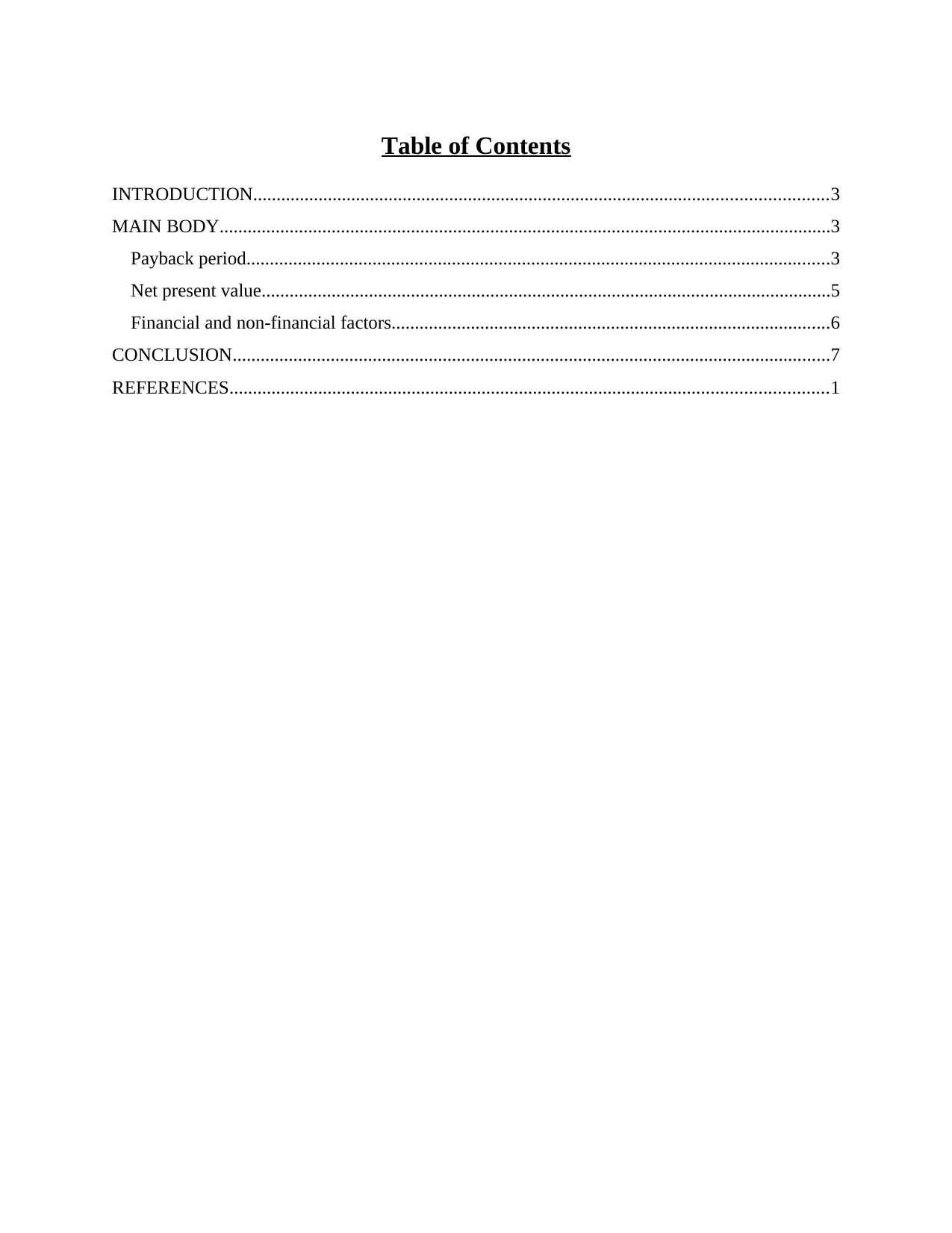
Table of Contents
INTRODUCTION...........................................................................................................................3
MAIN BODY...................................................................................................................................3
Payback period.............................................................................................................................3
Net present value..........................................................................................................................5
Financial and non-financial factors..............................................................................................6
CONCLUSION................................................................................................................................7
REFERENCES................................................................................................................................1
INTRODUCTION...........................................................................................................................3
MAIN BODY...................................................................................................................................3
Payback period.............................................................................................................................3
Net present value..........................................................................................................................5
Financial and non-financial factors..............................................................................................6
CONCLUSION................................................................................................................................7
REFERENCES................................................................................................................................1
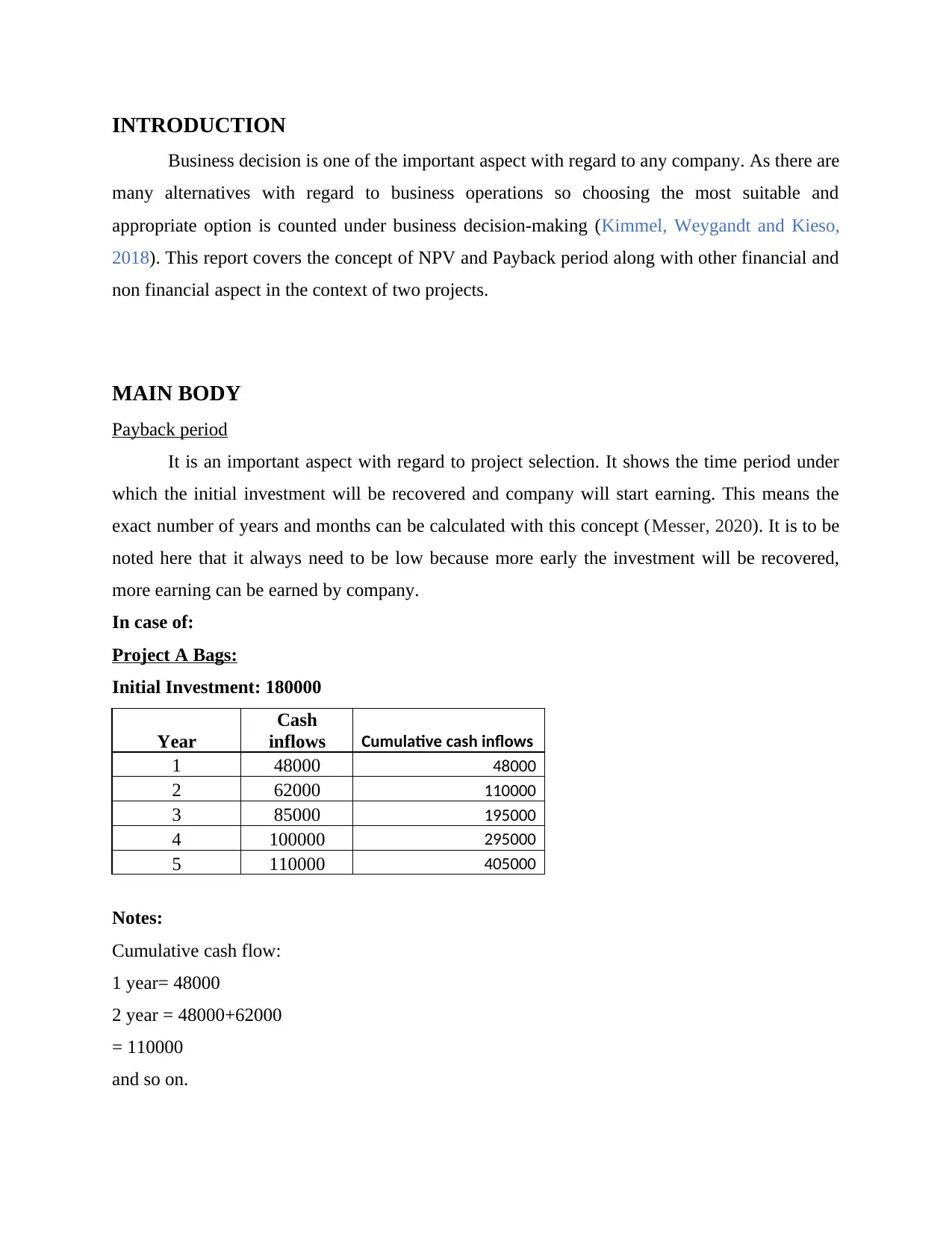
INTRODUCTION
Business decision is one of the important aspect with regard to any company. As there are
many alternatives with regard to business operations so choosing the most suitable and
appropriate option is counted under business decision-making (Kimmel, Weygandt and Kieso,
2018). This report covers the concept of NPV and Payback period along with other financial and
non financial aspect in the context of two projects.
MAIN BODY
Payback period
It is an important aspect with regard to project selection. It shows the time period under
which the initial investment will be recovered and company will start earning. This means the
exact number of years and months can be calculated with this concept (Messer, 2020). It is to be
noted here that it always need to be low because more early the investment will be recovered,
more earning can be earned by company.
In case of:
Project A Bags:
Initial Investment: 180000
Year
Cash
inflows Cumulative cash inflows
1 48000 48000
2 62000 110000
3 85000 195000
4 100000 295000
5 110000 405000
Notes:
Cumulative cash flow:
1 year= 48000
2 year = 48000+62000
= 110000
and so on.
Business decision is one of the important aspect with regard to any company. As there are
many alternatives with regard to business operations so choosing the most suitable and
appropriate option is counted under business decision-making (Kimmel, Weygandt and Kieso,
2018). This report covers the concept of NPV and Payback period along with other financial and
non financial aspect in the context of two projects.
MAIN BODY
Payback period
It is an important aspect with regard to project selection. It shows the time period under
which the initial investment will be recovered and company will start earning. This means the
exact number of years and months can be calculated with this concept (Messer, 2020). It is to be
noted here that it always need to be low because more early the investment will be recovered,
more earning can be earned by company.
In case of:
Project A Bags:
Initial Investment: 180000
Year
Cash
inflows Cumulative cash inflows
1 48000 48000
2 62000 110000
3 85000 195000
4 100000 295000
5 110000 405000
Notes:
Cumulative cash flow:
1 year= 48000
2 year = 48000+62000
= 110000
and so on.
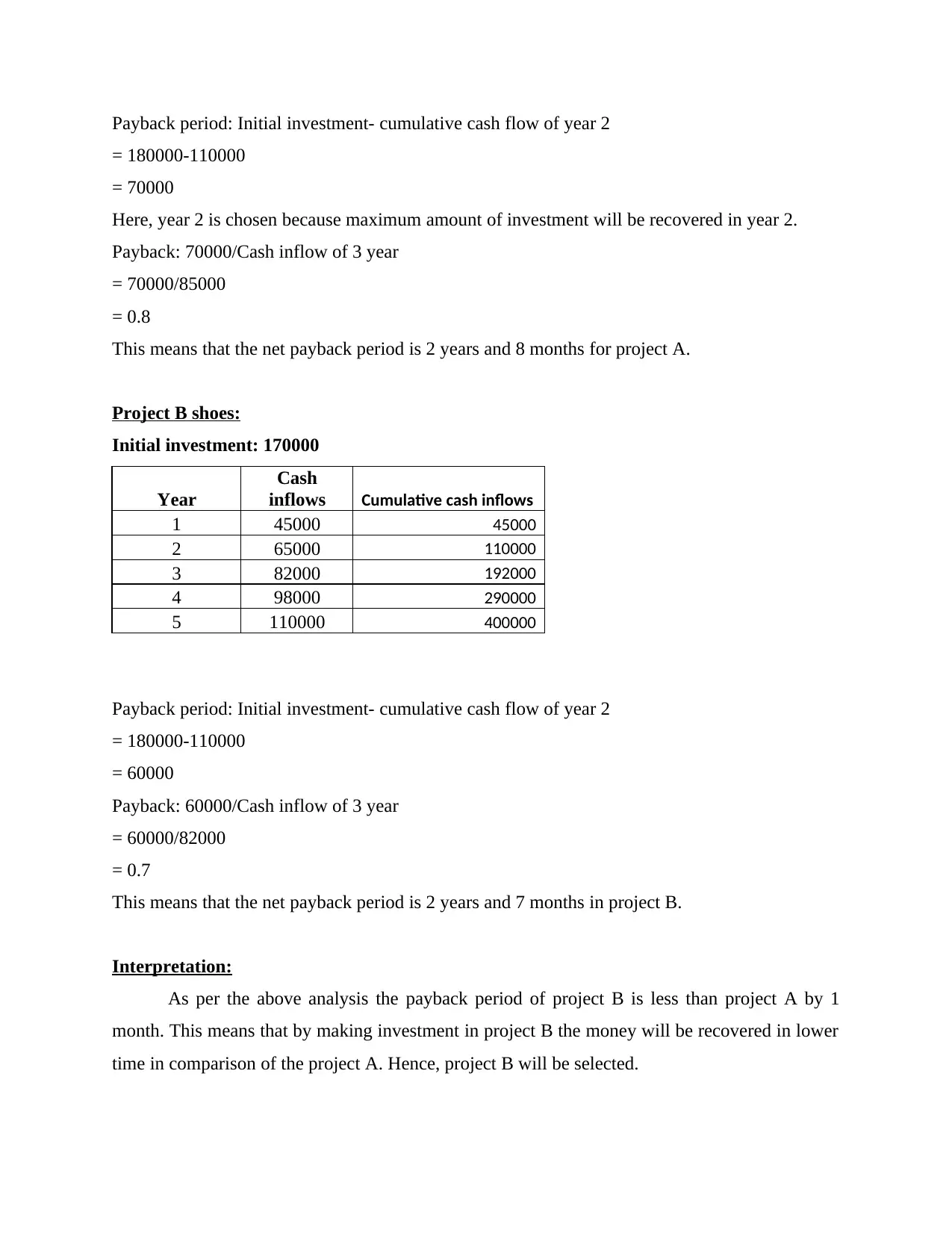
Payback period: Initial investment- cumulative cash flow of year 2
= 180000-110000
= 70000
Here, year 2 is chosen because maximum amount of investment will be recovered in year 2.
Payback: 70000/Cash inflow of 3 year
= 70000/85000
= 0.8
This means that the net payback period is 2 years and 8 months for project A.
Project B shoes:
Initial investment: 170000
Year
Cash
inflows Cumulative cash inflows
1 45000 45000
2 65000 110000
3 82000 192000
4 98000 290000
5 110000 400000
Payback period: Initial investment- cumulative cash flow of year 2
= 180000-110000
= 60000
Payback: 60000/Cash inflow of 3 year
= 60000/82000
= 0.7
This means that the net payback period is 2 years and 7 months in project B.
Interpretation:
As per the above analysis the payback period of project B is less than project A by 1
month. This means that by making investment in project B the money will be recovered in lower
time in comparison of the project A. Hence, project B will be selected.
= 180000-110000
= 70000
Here, year 2 is chosen because maximum amount of investment will be recovered in year 2.
Payback: 70000/Cash inflow of 3 year
= 70000/85000
= 0.8
This means that the net payback period is 2 years and 8 months for project A.
Project B shoes:
Initial investment: 170000
Year
Cash
inflows Cumulative cash inflows
1 45000 45000
2 65000 110000
3 82000 192000
4 98000 290000
5 110000 400000
Payback period: Initial investment- cumulative cash flow of year 2
= 180000-110000
= 60000
Payback: 60000/Cash inflow of 3 year
= 60000/82000
= 0.7
This means that the net payback period is 2 years and 7 months in project B.
Interpretation:
As per the above analysis the payback period of project B is less than project A by 1
month. This means that by making investment in project B the money will be recovered in lower
time in comparison of the project A. Hence, project B will be selected.
Secure Best Marks with AI Grader
Need help grading? Try our AI Grader for instant feedback on your assignments.
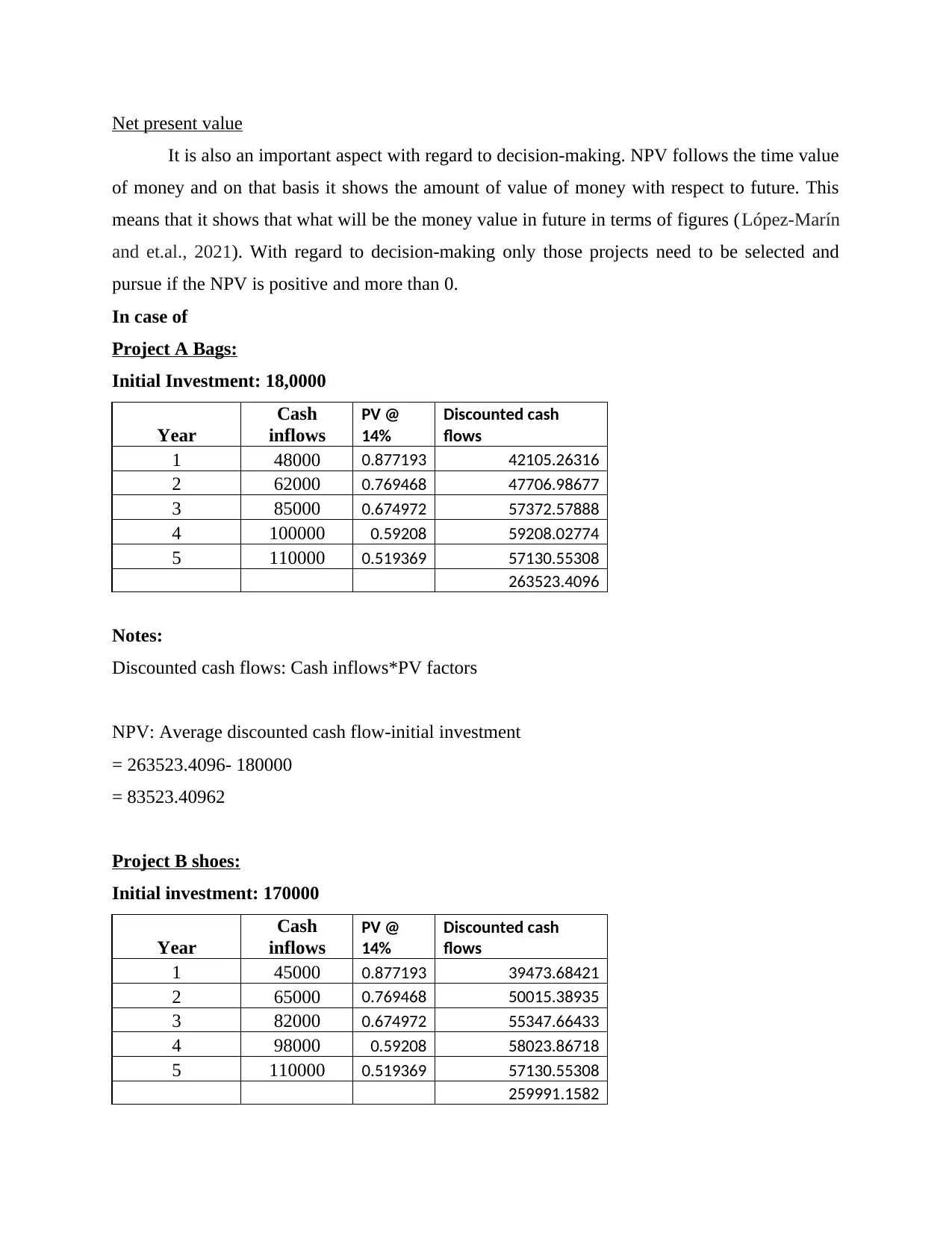
Net present value
It is also an important aspect with regard to decision-making. NPV follows the time value
of money and on that basis it shows the amount of value of money with respect to future. This
means that it shows that what will be the money value in future in terms of figures (López-Marín
and et.al., 2021). With regard to decision-making only those projects need to be selected and
pursue if the NPV is positive and more than 0.
In case of
Project A Bags:
Initial Investment: 18,0000
Year
Cash
inflows
PV @
14%
Discounted cash
flows
1 48000 0.877193 42105.26316
2 62000 0.769468 47706.98677
3 85000 0.674972 57372.57888
4 100000 0.59208 59208.02774
5 110000 0.519369 57130.55308
263523.4096
Notes:
Discounted cash flows: Cash inflows*PV factors
NPV: Average discounted cash flow-initial investment
= 263523.4096- 180000
= 83523.40962
Project B shoes:
Initial investment: 170000
Year
Cash
inflows
PV @
14%
Discounted cash
flows
1 45000 0.877193 39473.68421
2 65000 0.769468 50015.38935
3 82000 0.674972 55347.66433
4 98000 0.59208 58023.86718
5 110000 0.519369 57130.55308
259991.1582
It is also an important aspect with regard to decision-making. NPV follows the time value
of money and on that basis it shows the amount of value of money with respect to future. This
means that it shows that what will be the money value in future in terms of figures (López-Marín
and et.al., 2021). With regard to decision-making only those projects need to be selected and
pursue if the NPV is positive and more than 0.
In case of
Project A Bags:
Initial Investment: 18,0000
Year
Cash
inflows
PV @
14%
Discounted cash
flows
1 48000 0.877193 42105.26316
2 62000 0.769468 47706.98677
3 85000 0.674972 57372.57888
4 100000 0.59208 59208.02774
5 110000 0.519369 57130.55308
263523.4096
Notes:
Discounted cash flows: Cash inflows*PV factors
NPV: Average discounted cash flow-initial investment
= 263523.4096- 180000
= 83523.40962
Project B shoes:
Initial investment: 170000
Year
Cash
inflows
PV @
14%
Discounted cash
flows
1 45000 0.877193 39473.68421
2 65000 0.769468 50015.38935
3 82000 0.674972 55347.66433
4 98000 0.59208 58023.86718
5 110000 0.519369 57130.55308
259991.1582
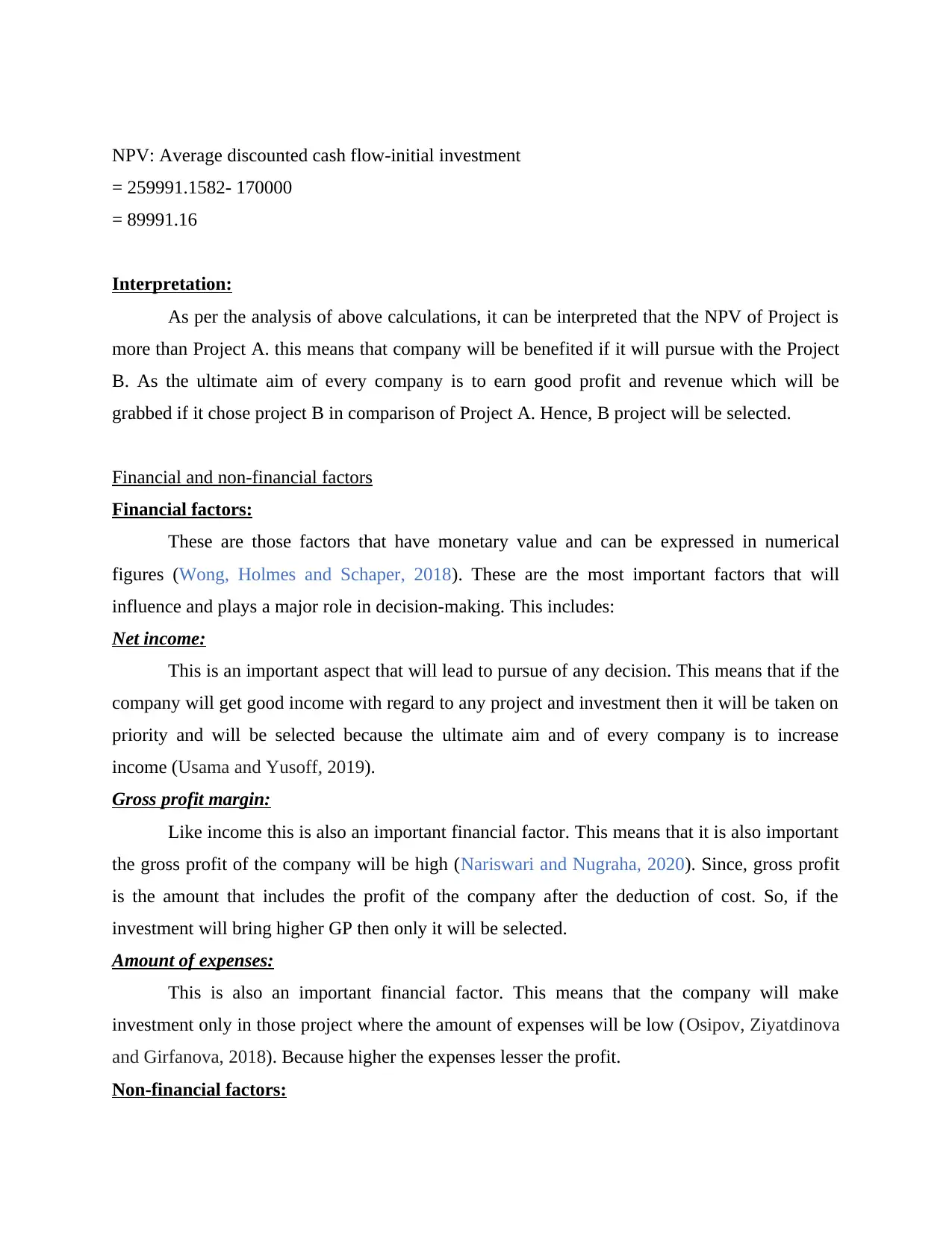
NPV: Average discounted cash flow-initial investment
= 259991.1582- 170000
= 89991.16
Interpretation:
As per the analysis of above calculations, it can be interpreted that the NPV of Project is
more than Project A. this means that company will be benefited if it will pursue with the Project
B. As the ultimate aim of every company is to earn good profit and revenue which will be
grabbed if it chose project B in comparison of Project A. Hence, B project will be selected.
Financial and non-financial factors
Financial factors:
These are those factors that have monetary value and can be expressed in numerical
figures (Wong, Holmes and Schaper, 2018). These are the most important factors that will
influence and plays a major role in decision-making. This includes:
Net income:
This is an important aspect that will lead to pursue of any decision. This means that if the
company will get good income with regard to any project and investment then it will be taken on
priority and will be selected because the ultimate aim and of every company is to increase
income (Usama and Yusoff, 2019).
Gross profit margin:
Like income this is also an important financial factor. This means that it is also important
the gross profit of the company will be high (Nariswari and Nugraha, 2020). Since, gross profit
is the amount that includes the profit of the company after the deduction of cost. So, if the
investment will bring higher GP then only it will be selected.
Amount of expenses:
This is also an important financial factor. This means that the company will make
investment only in those project where the amount of expenses will be low (Osipov, Ziyatdinova
and Girfanova, 2018). Because higher the expenses lesser the profit.
Non-financial factors:
= 259991.1582- 170000
= 89991.16
Interpretation:
As per the analysis of above calculations, it can be interpreted that the NPV of Project is
more than Project A. this means that company will be benefited if it will pursue with the Project
B. As the ultimate aim of every company is to earn good profit and revenue which will be
grabbed if it chose project B in comparison of Project A. Hence, B project will be selected.
Financial and non-financial factors
Financial factors:
These are those factors that have monetary value and can be expressed in numerical
figures (Wong, Holmes and Schaper, 2018). These are the most important factors that will
influence and plays a major role in decision-making. This includes:
Net income:
This is an important aspect that will lead to pursue of any decision. This means that if the
company will get good income with regard to any project and investment then it will be taken on
priority and will be selected because the ultimate aim and of every company is to increase
income (Usama and Yusoff, 2019).
Gross profit margin:
Like income this is also an important financial factor. This means that it is also important
the gross profit of the company will be high (Nariswari and Nugraha, 2020). Since, gross profit
is the amount that includes the profit of the company after the deduction of cost. So, if the
investment will bring higher GP then only it will be selected.
Amount of expenses:
This is also an important financial factor. This means that the company will make
investment only in those project where the amount of expenses will be low (Osipov, Ziyatdinova
and Girfanova, 2018). Because higher the expenses lesser the profit.
Non-financial factors:
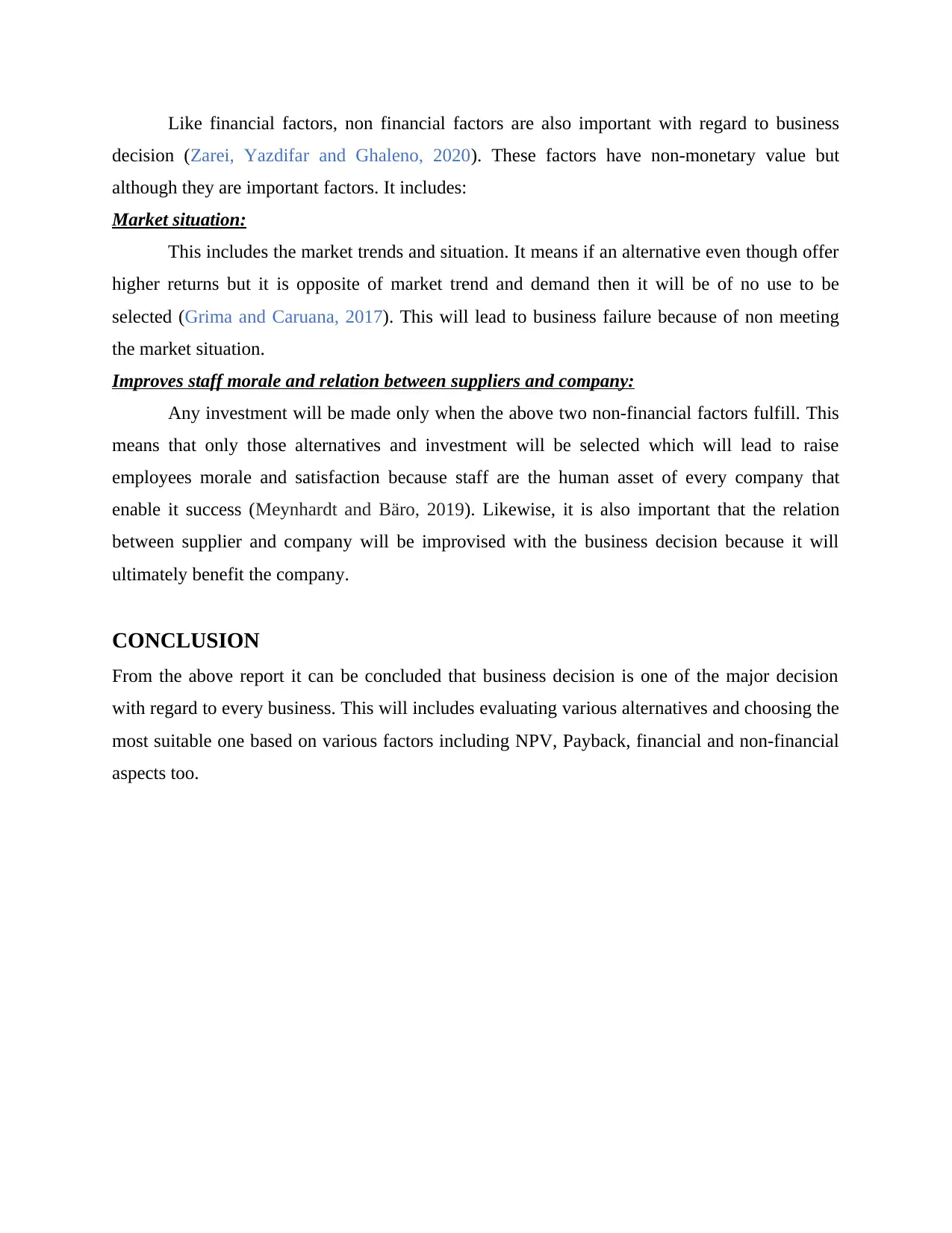
Like financial factors, non financial factors are also important with regard to business
decision (Zarei, Yazdifar and Ghaleno, 2020). These factors have non-monetary value but
although they are important factors. It includes:
Market situation:
This includes the market trends and situation. It means if an alternative even though offer
higher returns but it is opposite of market trend and demand then it will be of no use to be
selected (Grima and Caruana, 2017). This will lead to business failure because of non meeting
the market situation.
Improves staff morale and relation between suppliers and company:
Any investment will be made only when the above two non-financial factors fulfill. This
means that only those alternatives and investment will be selected which will lead to raise
employees morale and satisfaction because staff are the human asset of every company that
enable it success (Meynhardt and Bäro, 2019). Likewise, it is also important that the relation
between supplier and company will be improvised with the business decision because it will
ultimately benefit the company.
CONCLUSION
From the above report it can be concluded that business decision is one of the major decision
with regard to every business. This will includes evaluating various alternatives and choosing the
most suitable one based on various factors including NPV, Payback, financial and non-financial
aspects too.
decision (Zarei, Yazdifar and Ghaleno, 2020). These factors have non-monetary value but
although they are important factors. It includes:
Market situation:
This includes the market trends and situation. It means if an alternative even though offer
higher returns but it is opposite of market trend and demand then it will be of no use to be
selected (Grima and Caruana, 2017). This will lead to business failure because of non meeting
the market situation.
Improves staff morale and relation between suppliers and company:
Any investment will be made only when the above two non-financial factors fulfill. This
means that only those alternatives and investment will be selected which will lead to raise
employees morale and satisfaction because staff are the human asset of every company that
enable it success (Meynhardt and Bäro, 2019). Likewise, it is also important that the relation
between supplier and company will be improvised with the business decision because it will
ultimately benefit the company.
CONCLUSION
From the above report it can be concluded that business decision is one of the major decision
with regard to every business. This will includes evaluating various alternatives and choosing the
most suitable one based on various factors including NPV, Payback, financial and non-financial
aspects too.
Paraphrase This Document
Need a fresh take? Get an instant paraphrase of this document with our AI Paraphraser
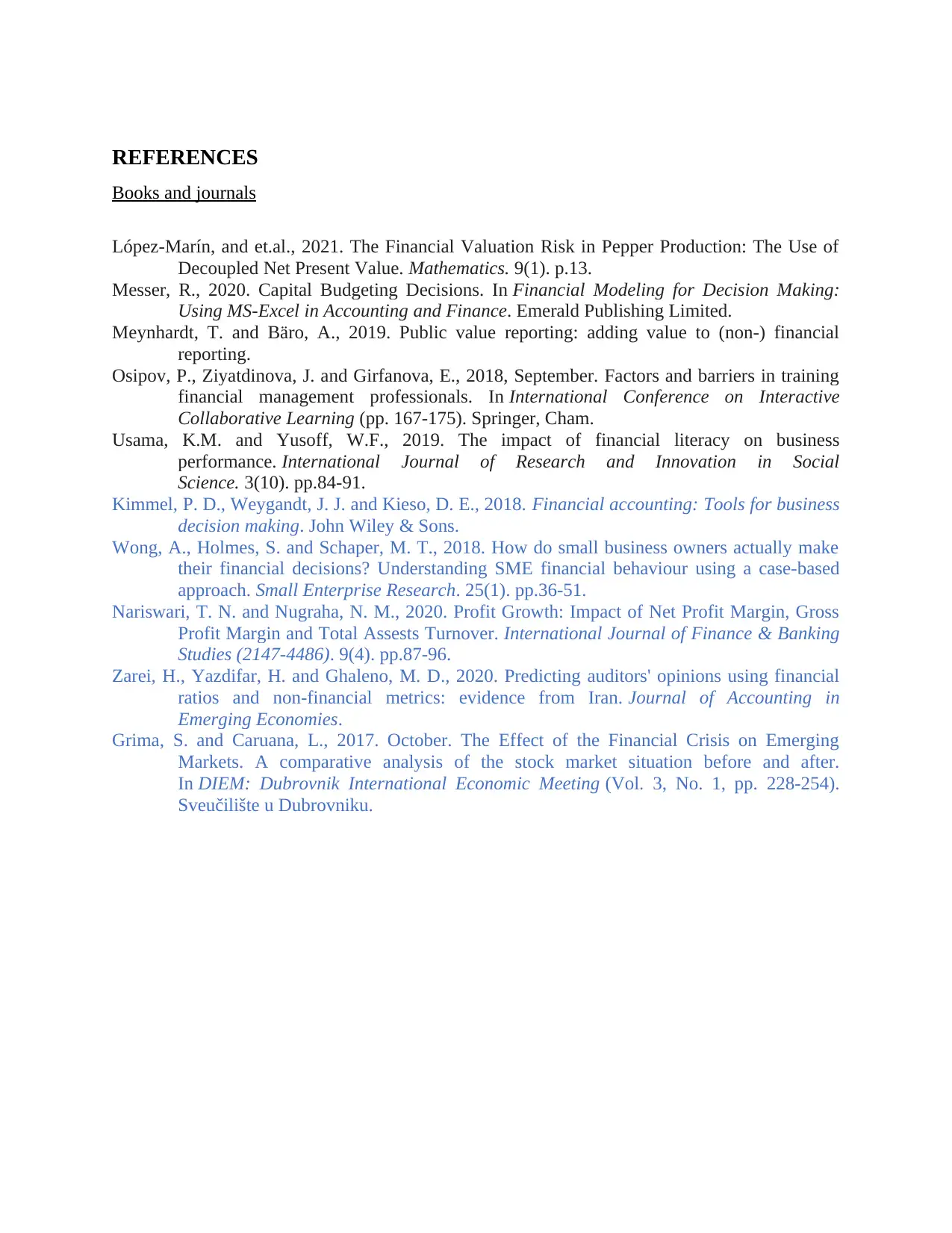
REFERENCES
Books and journals
López-Marín, and et.al., 2021. The Financial Valuation Risk in Pepper Production: The Use of
Decoupled Net Present Value. Mathematics. 9(1). p.13.
Messer, R., 2020. Capital Budgeting Decisions. In Financial Modeling for Decision Making:
Using MS-Excel in Accounting and Finance. Emerald Publishing Limited.
Meynhardt, T. and Bäro, A., 2019. Public value reporting: adding value to (non-) financial
reporting.
Osipov, P., Ziyatdinova, J. and Girfanova, E., 2018, September. Factors and barriers in training
financial management professionals. In International Conference on Interactive
Collaborative Learning (pp. 167-175). Springer, Cham.
Usama, K.M. and Yusoff, W.F., 2019. The impact of financial literacy on business
performance. International Journal of Research and Innovation in Social
Science. 3(10). pp.84-91.
Kimmel, P. D., Weygandt, J. J. and Kieso, D. E., 2018. Financial accounting: Tools for business
decision making. John Wiley & Sons.
Wong, A., Holmes, S. and Schaper, M. T., 2018. How do small business owners actually make
their financial decisions? Understanding SME financial behaviour using a case-based
approach. Small Enterprise Research. 25(1). pp.36-51.
Nariswari, T. N. and Nugraha, N. M., 2020. Profit Growth: Impact of Net Profit Margin, Gross
Profit Margin and Total Assests Turnover. International Journal of Finance & Banking
Studies (2147-4486). 9(4). pp.87-96.
Zarei, H., Yazdifar, H. and Ghaleno, M. D., 2020. Predicting auditors' opinions using financial
ratios and non-financial metrics: evidence from Iran. Journal of Accounting in
Emerging Economies.
Grima, S. and Caruana, L., 2017. October. The Effect of the Financial Crisis on Emerging
Markets. A comparative analysis of the stock market situation before and after.
In DIEM: Dubrovnik International Economic Meeting (Vol. 3, No. 1, pp. 228-254).
Sveučilište u Dubrovniku.
Books and journals
López-Marín, and et.al., 2021. The Financial Valuation Risk in Pepper Production: The Use of
Decoupled Net Present Value. Mathematics. 9(1). p.13.
Messer, R., 2020. Capital Budgeting Decisions. In Financial Modeling for Decision Making:
Using MS-Excel in Accounting and Finance. Emerald Publishing Limited.
Meynhardt, T. and Bäro, A., 2019. Public value reporting: adding value to (non-) financial
reporting.
Osipov, P., Ziyatdinova, J. and Girfanova, E., 2018, September. Factors and barriers in training
financial management professionals. In International Conference on Interactive
Collaborative Learning (pp. 167-175). Springer, Cham.
Usama, K.M. and Yusoff, W.F., 2019. The impact of financial literacy on business
performance. International Journal of Research and Innovation in Social
Science. 3(10). pp.84-91.
Kimmel, P. D., Weygandt, J. J. and Kieso, D. E., 2018. Financial accounting: Tools for business
decision making. John Wiley & Sons.
Wong, A., Holmes, S. and Schaper, M. T., 2018. How do small business owners actually make
their financial decisions? Understanding SME financial behaviour using a case-based
approach. Small Enterprise Research. 25(1). pp.36-51.
Nariswari, T. N. and Nugraha, N. M., 2020. Profit Growth: Impact of Net Profit Margin, Gross
Profit Margin and Total Assests Turnover. International Journal of Finance & Banking
Studies (2147-4486). 9(4). pp.87-96.
Zarei, H., Yazdifar, H. and Ghaleno, M. D., 2020. Predicting auditors' opinions using financial
ratios and non-financial metrics: evidence from Iran. Journal of Accounting in
Emerging Economies.
Grima, S. and Caruana, L., 2017. October. The Effect of the Financial Crisis on Emerging
Markets. A comparative analysis of the stock market situation before and after.
In DIEM: Dubrovnik International Economic Meeting (Vol. 3, No. 1, pp. 228-254).
Sveučilište u Dubrovniku.

1
1 out of 9
Related Documents
Your All-in-One AI-Powered Toolkit for Academic Success.
+13062052269
info@desklib.com
Available 24*7 on WhatsApp / Email
![[object Object]](/_next/static/media/star-bottom.7253800d.svg)
Unlock your academic potential
© 2024 | Zucol Services PVT LTD | All rights reserved.


